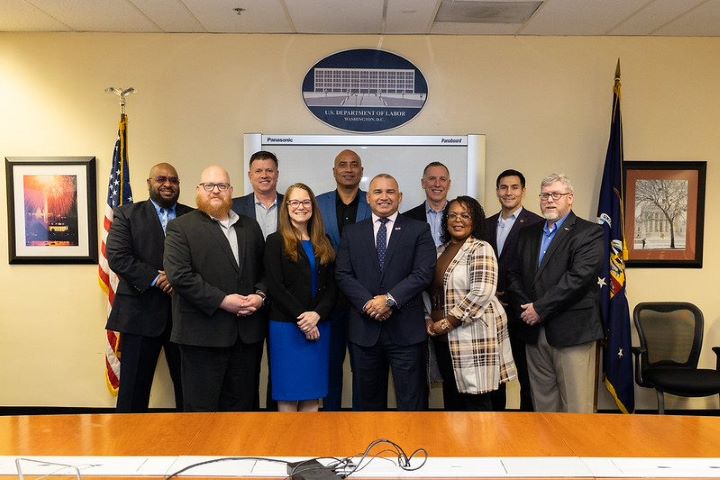
Pictured from left to right: André Anderson, Atlanta Region RVEC; David Seay, Chicago Region RVEC; Eric Asmussen, Nation Veterans Employment Manager; J. Margarita Devlin, Deputy Assistant Secretary; Tony Forbes, San Francisco RVEC; James D. Rodriguez, Assistant Secretary; Mark J. Toal, Director, Office of Strategic Outreach; Janice Maupin-Anderson, Dallas Region RVEC; Matthew Passmore, Philadelphia Region RVEC; Paul Furbush, Boston Region RVEC
It’s 6 a.m. and the sun is rising in San Antonio, Texas, as another email dings in the inbox. It’s a manufacturing company looking for experienced leaders to fill some of their management positions. Janice Maupin-Anderson, a Regional Veterans’ Employment Coordinator (RVEC), quickly responds to the email and coordinates a meeting. As a RVEC, Maupin-Anderson meets with employers throughout her 11-state region to best understand their needs and to connect them with resources to assist them in finding and hiring veterans. With back-to-back meetings on any given day, her dynamic job keeps her fully engaged, but she wouldn’t want it any other way.
Maupin-Anderson enjoys helping veterans, maybe it’s because she’s a veteran herself. Like many others, she chose a path of continued service in her post-military career. Janice served for more than 29 years and retired from the Air Force as a chief master sergeant. After she transitioned from active duty, she took a few months off to reset, and then decided to visit a local American Job Center. There she found a job as a work-study with the Department of Veterans Affairs. It was rewarding helping others in the military community, so she continued the path and became an employment specialist focused on working with veterans at the center.
After decades of service, Maupin-Anderson understood the challenges of transitioning from the military to the private sector and she liked assisting veterans navigate the employment process. She was eventually recruited to be a Disabled Veterans’ Outreach Program Specialist (DVOP), where she helped veterans with significant barriers to employment find the right position to meet their needs.
After nearly a year as a DVOP, Maupin-Anderson was offered the opportunity to become a Local Veterans’ Employment Representative (LVER), where she worked with employers to help connect them to job-seeking veterans. By this time, her knowledge and experience had well prepared her for the challenges she would face as the Assistant Director of Veterans’ Employment and Training Service for the state of Texas. She worked in that role for several years before becoming the RVEC for the Dallas Region which covers eleven states from Louisiana to Montana. While she spent much of her career educating veterans about the employment process, she saw the RVEC position as a chance to reverse the roles and work with employers to help them find service members, veterans, and military spouses.
“The best part of my job is when an employer who’s looking to hire veterans reaches out to me, and I can refer them to the DVOP and LVER at the local American Job Center. The DVOP and LVER have a talent pool of job-ready candidates and one of those veterans is selected from that talent pool and hired by the employer. The VETS state director, LVERs and DVOPs function as a team which enables us to assist employers with hiring veterans and to help place veterans in meaningful careers that allow them to take care of their families,” said Maupin-Anderson.
She also mentioned that one of the biggest challenges that employers face when trying to employ veterans is not knowing where to go to locate veteran job seekers or about the no-cost resources available to help employers grow their workforce. Many of them are not aware of the Jobs for Veterans State Grants (JVSG) staff who are located at American Job Centers specifically to assist employers with locating veteran job seekers.
This is where Maupin-Anderson and the other five RVECs come in. This employer outreach team connects employers with federal, state and other resources to make it easier for employers to find, recruit and hire service members, veterans and military spouses.
If you’re an employer seeking to hire veterans, the Veterans’ Employment and Training Service staff is ready to help. Please reach out to your local RVEC for assistance.
Access the DOL Employer Guide to Hiring Veterans and find more information on Veterans’ Employment and Training Service resources and programs at https://www.dol.gov/agencies/vets.
Dana Kelly is a communications specialist with the Department of Labor Veterans’ Employment and Training Service and a proud 21-year veteran of the United States Army. Follow VETS on Twitter and LinkedIn.

 U.S. Department of Labor Blog
U.S. Department of Labor Blog